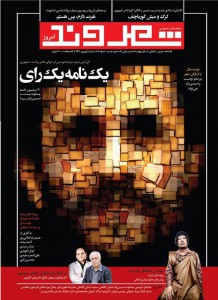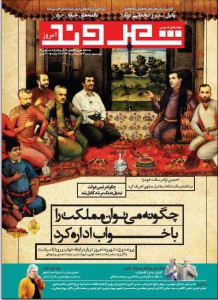New York, September 9, 2011–The Committee to Protect Journalists condemns the forced closure of two independent Iranian newspapers on Monday and the arrest of an Iranian writer in the city of Tabriz.
In July and August, Shahrvand-e Emrooz (Today’s Citizen), a reformist weekly, ran two covers depicting President Mahmoud Ahmadinejad in a satirical light. The paper was banned indefinitely under Article 6 of the Iranian Press Law, which prohibits “insulting legal or real persons who are lawfully respected, even by means of pictures or caricatures,” the International Campaign for Human Rights in Iran (ICHRI) reported.
The reformist daily Roozegar was also banned for two months, starting September 5, on charges of “propagating against the regime and publishing state secrets,” according to an order from the Ninth Branch of Tehran’s Culture and Media Court, the BBC Persian Service reported. CPJ could not verify the reason for the newspaper’s ban.
“Iran’s knee-jerk response to critical reporting and commentary as ever is to jail the journalist and close down the journal,” said CPJ Deputy Director Robert Mahoney. “The authorities should immediately lift the ban on Shahrvand-e Emrooz and Roozegar. At least the staff members of those two publications have the consolation of knowing that their journalism hit the mark.”

In July, Shahrvand-e Emrooz ran a digitally manipulated cover of President Mahmoud Ahmadinejad being lectured by his chief-of-staff in 16th-century Persian dynasty-style clothing, a source close to the paper told the ICHRI. However, other reports suggest the ban could also be a result of another digitally created cover the paper ran in August, this one depicting a collage of Ahmadinejad’s face made up by several small envelopes. This referred to the president courting constituents who write to him and providing them with monetary benefits in return. Shahrvand-e Emrooz was previously banned in 2009 but resumed circulation this July, news reports said.
Roozegar was banned in 2006 on charges that its logo resembled Shargh, the last of the journals favoring the former President Mohamed Khatami, but it resumed publication this February.
Faranak Farid, editor-in-chief of the banned monthly Dilmaj and a women’s rights activist, was reportedly arrested during protests against government inaction regarding the drying of Lake Oroumiyeh in the major industrial city of Tabriz, local news reports said. Her whereabouts and the reason for her arrest are unknown.
CPJ has documented the continuous arrest and imprisonment of journalists in Iran. In the government’s latest crackdown on critical journalists, authorities extended the term of veteran journalist Isaa Saharkhiz, re-arrested Committee of Human Rights Reporters (CHRR) writer Kouhyar Goudarzi and his mother, and summoned Ali Kalaee, a former member of CHRR, to serve a seven-year prison sentence. Last year, Iran was tied with China for the number of most imprisoned journalists, at 34, according to CPJ’s annual census.
